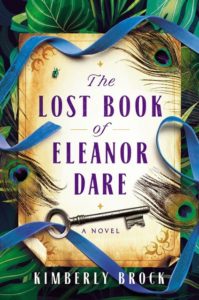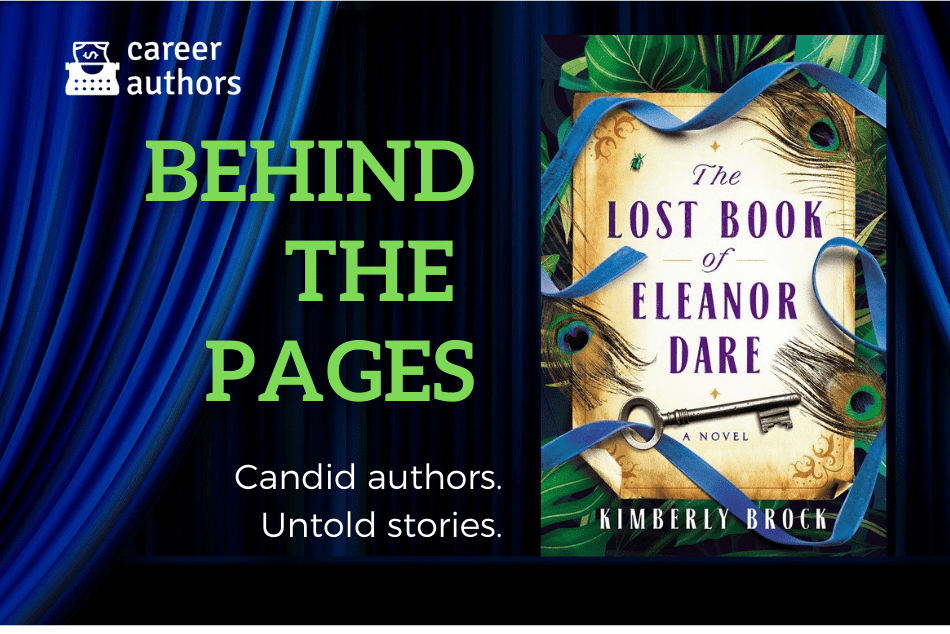One of the things we love at Career Authors is to find out what changes, calculations and revisions went into a final polished novel. What you see in libraries and bookstores is the product of a whole teams of people, each with their own specialty and unique knowledge. How does that work? How do books change along the way? What happens inside that process? The surprises, the pitfalls, the realizations, the successes. On April 12, award-winning author, writer, lecturer and teacher Kimberly Brock released her first historical, THE LOST BOOK OF ELEANOR DARE. What a milestone! And now, you see the result–Adriana Trigiani calls it “compelling and immersive”. What’s behind the pages? We asked, Kimberly answered.
1. What’s the title of your book—and was that always the title?
The title is The Lost Book of Eleanor Dare, but the original working title that stayed with me all the way through the writing and submission process was Evertell.
2. Who’s the main character of your book—and was that always their name?
The main character is a young war widow and mother to a thirteen-year-old daughter. Her name is Alice Young. I think her name changed at least a dozen times before I came to Alice, which stuck and stayed that way through edits.
3. At the start of the book, what’s the character’s goal?
Alice’s husband has died early in the war and then her father dies of a stroke. She discovers she has the deed to her mother’s matriarchal home which was abandoned during Alice’s early teen years. She sees an opportunity for closure with the bitter history of the place and memories of the loss of her mother, and also a way to financially support her own daughter’s education, by selling the estate. Alice really want to put the past to rest and make something good, a fresh start, from the heartache of her childhood.
4. What was the core idea for this novel—a plot point? a theme?—and where did it come from?
I first learned of the obscure history of the Dare Stone almost twenty years ago. As a mother raising my own children, over the years I reflected on the story of the stone, that it was believed to have been carved by Eleanor White Dare, a survivor of the Lost Colony of Roanoke. I thought a lot about what it might have felt like to have been Eleanor, a young mother and suddenly alone in a wilderness, desperate to leave a mark that would remember me to the world and more importantly, to my daughter and her descendants. Womens’ history is so often lost, our stories left untold. I wondered what story Eleanor’s descendants might have passed down, mother to daughter, about her and how they might have treasured that story. And I was very interested in how the stories women cherish about the lives of their forebears helps define them, gives courage, and inspires them to move through the world. How we find our way home.
5. At what point did you come up with the final version of the first line?
I had written the first chapter multiple times when my agent and her assistant and I stumbled across the idea for the first line during a brainstorming call, probably only a few months before the book was completed. It is: “The summer I turned thirteen, my mother took me into the forest to work a charm that was my right from birth.”
6. Did you know the ending of the book when you started?
Yes. I did rewrite it multiple times, including removing an entire plot point and a main character, but I knew how Alice and Penn’s story would end when I began to write the novel.
7. What’s something in this book that you’ve never done before?
I have never written a historical fiction! There was an incredible amount of research to be done.
8. What part of your tour (or launch week) are you most excited about?
I look forward to gathering with friends and family who have been supportive over so many years of writing and research and just living with the idea of Eleanor Dare, trying to do justice to this story. And I look forward to sitting with readers and chatting about their thoughts after they’ve read the book!
9. Who in your #writingcommunity deserves a special shout-out for supporting you in writing this story?
I couldn’t list them all if I tried! My acknowledgments for this book are outrageously long. The writing community at large is such an amazing world and I have been one lucky writer in that almost every relationship I’ve formed over the last decade has been a supportive one. In particular, the women writers I have met have almost always been incredible – from early days at Georgia Romance Writers, to more recent friendships through the Womens Fiction Writers Association, SheReads.org., book bloggers and bookstagrammers, amazing women running book festivals and bookstores, the Tall Poppy Writers, my team at Browne & Miller Literary Associates and at Harper Muse Books, to the treasured women who have attended Tinderbox Writers Workshops and Retreats and become my family, and finally, my closest hometown pals and writing friends, Emily Carpenter and MJ Pullen.
10. How do you want readers to feel when they close the book?
Like it was written just for them. Like they’ve discovered a secret. I want them to hold it tight their chests and love the mystery most of all.
11. What did you learn from this book?
There’s an adage that says writers should write what they know. Alice Hoffman says we should write what we can imagine. It took many years and much encouragement from my literary agent before I would allow myself to even consider writing Eleanor’s Tale, the portion of this novel that imagines a future for Eleanor. I had filled notepads with fictional genealogical charts of names, birthdates, death dates and possible touchpoints in the lives of the heirs I privately imagined for Eleanor Dare, but to write a story for Eleanor felt sacrosanct for the longest time. I couldn’t bring myself to touch it. Then, I woke one night at about two in the morning with the first lines of a story whispering in my ears, a tale passed through generations of mothers and daughters, and I realized what a gift our stories are to one another. They recognize the lives that have been lived and even if they aren’t based in fact so much as they are based in memory, they are how we commemorate those who’ve come before us. They are how we dream and imagine our own way forward in an imperfect world. If I’ve learned anything from writing this novel (from Eleanor’s story and the very little we truly know of her) it is that stories are not the same as facts.
Stories are matters of the heart. A story doesn’t matter because it’s true, but because it has been told.
Kimberly Brock is the award-winning author of The Lost Book of Eleanor Dare and The River Witch. She is the founder of Tinderbox Writers Workshop and has served as a guest lecturer for many regional and
 national writing workshops including at the Pat Conroy Literary Center. She lives near Atlanta with her husband and three children. Visit her online at kimberlybrockbooks.com; Instagram: @kimberlydbrock; Facebook: @kimberlybrockauthor; Twitter: @kimberlydbrock.
national writing workshops including at the Pat Conroy Literary Center. She lives near Atlanta with her husband and three children. Visit her online at kimberlybrockbooks.com; Instagram: @kimberlydbrock; Facebook: @kimberlybrockauthor; Twitter: @kimberlydbrock.





